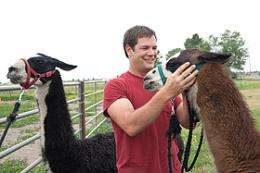Matt Rinella, shown here with his pet llamas, recently published an article in the journal Ecological Applications showing that it may not always pay for ranchers to use herbicides to kill invasive plants on rangelands.
(PhysOrg.com) -- Matt Rinella, faculty in Animal and Range Science at Montana State University and an ecologist at the Fort Keogh Agricultural Experiment Station in Miles City, recently published the results of a 16-year study in the journal Ecological Applications.
Rinella and his colleagues found that, due to an application of the herbicide Tordon made 16 years prior, native wildflowers--including Missouri goldenrod and yarrow--had been reduced to precipitously low levels and the target invasive weed (leafy spurge) had potentially increased. Although the herbicide dissipated after a few years, the plant community was permanently altered.
"There is some evidence that some of the native forbs went locally extinct," said Rinella.
When herbicide wasn't used, many native forbs did similarly well in grazed and non-grazed plots. Plots that were sprayed and grazed fared better than plots that were sprayed but not grazed. Cattle grazing can benefit native forbs because cattle prefer eating grass to forbs. Additionally, cattle trample the soil, loosening it for seeds that are inadvertently sown by cows. However, Missouri goldenrod and yarrow did not recover, regardless of grazing.
"The critical question was, 'Which was worse for native biota, invaders or things done to control invaders?'" asked Rinella.
Rinella's study was a continuation of a research project started by one of his graduate committee members, Bruce Maxwell, now faculty in land resource and environmental science at MSU.
"A study like this can tell us a lot about the long-term target and non-target effects of herbicides, so it's nice that Matt could keep working on this project," Maxwell said.
Maxwell studied the effectiveness of herbicide use in controlling leafy sprurge, an invasive plant, as part of his graduate research from 1982-1984. He made observations after 10,000 acres were sprayed--minus several areas covered with tarps--at the N-Bar Ranch near Grass Range, Mont. Fences kept cattle out of some of the sprayed plots and some of the non-sprayed plots, creating a mosaic of plots that were sprayed and grazed, sprayed and not grazed, not sprayed and grazed, and not sprayed and not grazed.
Sixteen years later Rinella, then a graduate student of Maxwell's, visited the N-Bar ranch with Maxwell, other students and faculty. The exclosures were still standing, presenting an opportunity to study how a one-time aerial spraying of herbicide and more than a decade of grazing affected the rangeland.
"Our cautionary tale is told using herbicide-treated grassland, but our results should be considered wherever invasive species management damages native species," said Rinella.
Provided by Montana State University (news : web)



















